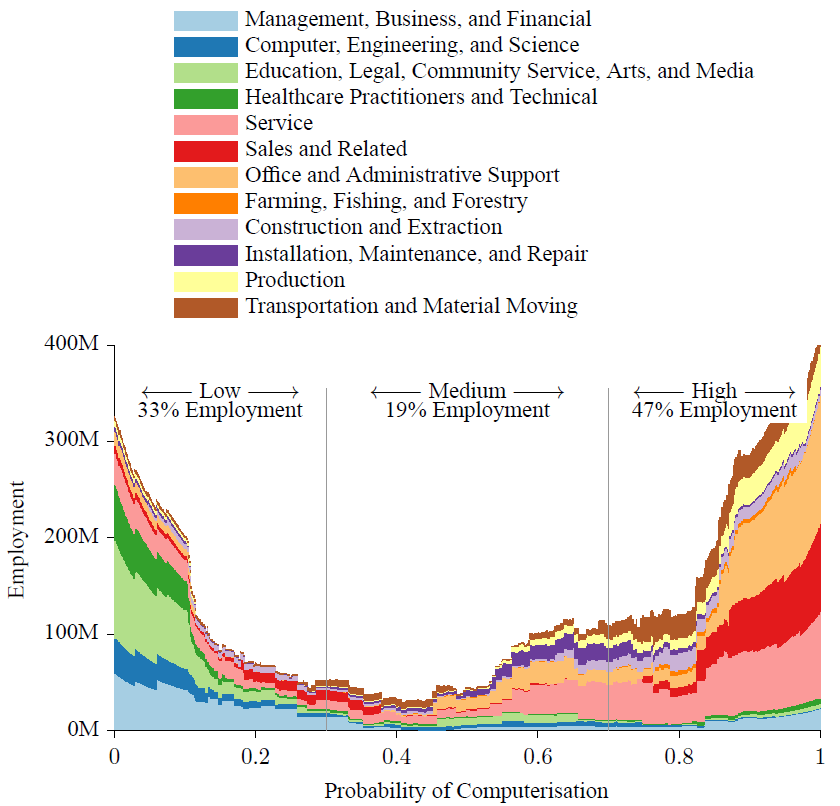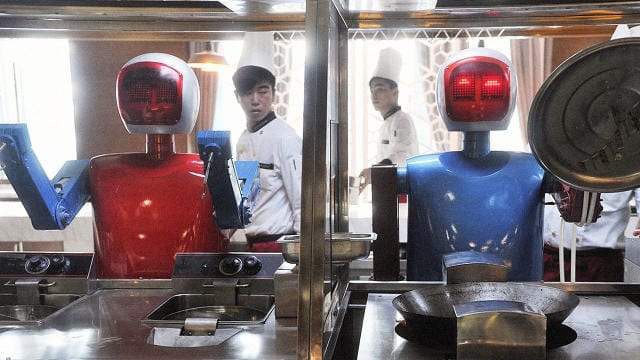
Transport, logistics, and office roles most likely to come under threat
Nearly half of U.S. jobs could be susceptible to computerization over the next two decades, a study from the Oxford Martin Programme on the Impacts of Future Technology suggests.
The study, a collaboration between Dr. Carl Benedikt Frey (Oxford Martin School) and Dr. Michael A. Osborne (Department of Engineering Science, University of Oxford), found that jobs in transportation, logistics, and office/administrative support are at “high risk” of automation.
More surprisingly, occupations within the service industry are also highly susceptible, despite recent job growth in this sector, they say.
“We identified several key bottlenecks currently preventing occupations being automated,” says Osborne. “As big data helps to overcome these obstacles, a great number of jobs will be put at risk.”
The study examined more than 700 detailed occupation types, noting the types of tasks workers perform and the skills required. By weighting these factors, as well as the engineering obstacles currently preventing computerization, the researchers assessed the degree to which these occupations may be automated in the coming decades.
The probability of computerization for the occupation types ranges from recreational therapists (the lowest ) to (thankfully) telemarketers, the highest probability (see report Appendix for the full list).
A move to ‘creative and social intelligence’ tasks
“Our findings imply that as technology races ahead, low-skilled workers will move to tasks that are not susceptible to computerization, i.e., tasks that require creative and social intelligence,” the paper states.
For example, while high-risk sales occupations (cashiers, counter and rental clerks, and telemarketers) interactive tasks, they do not necessarily require a high degree of social intelligence.
“For workers to win the race, however, they will have to acquire creative and social skills.”
Low-risk occupations
On the other hand, generalist occupations requiring knowledge of human heuristics, and specialist occupations involving the development of novel ideas and artifacts, are the least susceptible to computerization, the findings show.
The Latest Bing News on:
Jobs at high risk of automation
- 10 AI-impacted jobs and how they're expected to grow in the next decadeon May 7, 2024 at 7:36 am
A 2022 Bureau of Labor Statistics report identified 10 occupations facing a high risk of automation—yet BLS data additionally shows approximately 447,000 new jobs will be created by 2032 in those same ...
- What Generative AI Means for Data Jobson May 6, 2024 at 10:34 am
The technology-will-steal-your-job narrative has been around for at least 200 years. Some roles do disappear, but most simply evolve, adapt, and merge.
- Retailers Embrace AI: The Shift Towards Automationon May 6, 2024 at 1:15 am
Discover how AI is revolutionizing the retail sector, optimizing processes, enhancing customer satisfaction, and reshaping job roles.
- No jobs, no hope: how India and China are grappling with youth criseson May 5, 2024 at 2:19 am
India’s unemployment time bomb disproportionately affects young people, with many seeking work in war zones and as illegal immigrants. In China, as automation quickly replaces human labour, frustrated ...
- How 10 AI-impacted jobs are projected to growon May 1, 2024 at 11:52 am
Revelo used Bureau of Labor Statistics data to identify projected growth in 10 jobs that are expected to be affected by AI.
- AuditBoard upgrades its risk management platform with built-in LLM descriptionson April 26, 2024 at 2:35 am
Prior to AuditBoard, many auditors relied on off-the-shelf spreadsheet software which they had to manually adjust to fit their needs.
- 6 hidden risks of IT automationon April 1, 2024 at 5:00 pm
Automation is increasingly seen as a key IT strategy for competitive advantage, but pitfalls await those who fail to heed precautions. Automating business processes continues to be a high priority ...
- What White-Collar Jobs Are Safe From AI—And Which Professions Are Most At Risk?on February 28, 2024 at 5:00 am
automation and bringing aboard experienced professionals in this space. The redirection of funds and resources to this fast-emerging technology adds another layer of job risk for white-collar workers.
- 8 High-Paying Jobs That Are Not Future-Proof and May Be at Riskon December 10, 2023 at 6:13 am
Side Gig: Earn Up To $200/Hour With This Easy-To-Start Job ... a position at risk to AI encroachment would be well-served to hone their skills and tradecraft to a level of complexity and nuanced ...
- Is AI Going To Be A Jobs Killer? New Reports About The Future Of Workon July 15, 2019 at 6:18 am
What does it say? Only that the 47% of American jobs that falls into the “high risk” category, compared with other professions, are the most vulnerable to automation. The Economist ...
The Latest Google Headlines on:
Jobs at high risk of automation
[google_news title=”” keyword=”Jobs at high risk of automation” num_posts=”10″ blurb_length=”0″ show_thumb=”left”]
The Latest Bing News on:
Automation
- Tetra Tech acquires industrial automation tech integratoron May 9, 2024 at 9:55 am
Tetra Tech is continuing its work on building synergies between its federal and infrastructure business units.
- Automation tool aids tech-to-adviser transitionon May 9, 2024 at 9:28 am
A new service drive management system called techWALLhas helped smoothen the transition technicians have made adding service adviser duties at Shaheen Chevrolet's Oil Change & Tire Center.
- Automation supplier plots new HQ in Oakland Countyon May 9, 2024 at 8:50 am
Convergix Automation Solutions is planning to expand with a new Auburn Hills headquarters in a space abandoned by an automotive plastics and foam supplier in bankruptcy. The automation company will ...
- Keywords of the Datafied State: Automationon May 9, 2024 at 7:33 am
With co-authors, Maitreya Shah discusses "automation" for Data & Society's Keywords of the Datafied State essay collection.
- HotelRunner and Alesayi to boost Saudi tourism with AI and automationon May 9, 2024 at 4:09 am
The partnership will leverage HotelRunner's expertise in technology for sustainable growth within the travel sector.
- Rethinking DevOps and automation with a layered approachon May 8, 2024 at 5:00 pm
For all its benefits, automation is not something that can just be implemented blindly across the layers of the DevOps stack. If those functions aren’t working together, the automation in each layer ...
- Five Things to Consider Before Adopting Robotics for Warehouse Automationon May 8, 2024 at 10:54 am
Modern retailers have an incredible opportunity to futureproof their warehouse operations today, with the goal of increasing efficiency to meet this surging consumer demand.
- What 7 Analyst Ratings Have To Say About Rockwell Automationon May 8, 2024 at 4:01 am
Analysts' ratings for Rockwell Automation (NYSE:ROK) over the last quarter vary from bullish to bearish, as provided by 7 analysts. The table below provides a snapshot of their recent ratings, ...
- Analyst Maintains Buy Rating for Rockwell Automation, Anticipating Strong Recovery and Growth in FY25on May 8, 2024 at 3:10 am
Analyst Andrew Kaplowitz from Citi maintained a Buy rating on Rockwell Automation (ROK – Research Report) and decreased the price target ...
- Rockwell Automation Cuts Financial Guidance. The Stock Edges Higher.on May 7, 2024 at 8:44 am
The industrial-technology company predicted a decline in revenue, as well as cutting its forecast for earnings per share.
The Latest Google Headlines on:
Automation
[google_news title=”” keyword=”automation” num_posts=”10″ blurb_length=”0″ show_thumb=”left”]










